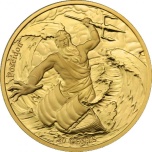Chinese lunar Fan-shaped coin collection
Price:
259,00 €
Weight: 29 g x 12 tk + 1 x 89 g
Metal: Cu/NI
Diameter: 12 x 44 x 26,8 mm ; 1 x 65 mm
Face value: 1/2 $ x 13
Quality: Proof-like
Mintage: 18 888 coins
Featuring the 12 lunar animals in traditional Chinese painting art on fan-shaped coins – the Chinese character of each animal is represented on individual designs.
The 12 zodiac animals are placed around one big coin with a diameter of 65 mm – all coins are refined with 24K Gold Plating.
The beautiful collection comes with a lucky mintage of 18,888 pieces – perfect as a subscription program or complete set!
Metal: Cu/NI
Diameter: 12 x 44 x 26,8 mm ; 1 x 65 mm
Face value: 1/2 $ x 13
Quality: Proof-like
Mintage: 18 888 coins
Featuring the 12 lunar animals in traditional Chinese painting art on fan-shaped coins – the Chinese character of each animal is represented on individual designs.
The 12 zodiac animals are placed around one big coin with a diameter of 65 mm – all coins are refined with 24K Gold Plating.
The beautiful collection comes with a lucky mintage of 18,888 pieces – perfect as a subscription program or complete set!
Similar products
Face value: 0.2 $
Issuing country: Samoa
Weight: 25 g
Diameter: 40 mm
Poseidon, as the god of water and of the sea, is the lord of sea creatures, so the sign of the pair of fish is more than appropriate. Pisces, however, also dives deeper in Poseidon’s realm. For starters, it is associated with the feet, and Poseidon is also a god of the earth, of tremors and geological processes, closely tied to water eroding rocks. The sea is also considered to be where the pillars of the universe are located in most western Eurasian religions, and in Greek thought Poseidon’s realm extends even to the Underworld, where the four rivers run, a connection particularly important in the more chthonic versions of Hellenic religion. If Cancer is the Moon and it’s spiritual essence while Scorpio is blood and the impulses, with Aquarius also representing sky waters, Pisces is simply the pure nature of water as an element, symbolizing the immensity of the seas and the many freshwater bodies. It’s the sign of mutability and change, resonating with water’s classical attribute as well as the very real quick and natural changes into ice, liquid, gas or cloud and also the currents. It also symbolizes Spring waters, be them from rains or melting snow and ice, feeding the fields and civilization, acting as water changing the surrounding environment.
Issuing country: Samoa
Weight: 25 g
Diameter: 40 mm
Poseidon, as the god of water and of the sea, is the lord of sea creatures, so the sign of the pair of fish is more than appropriate. Pisces, however, also dives deeper in Poseidon’s realm. For starters, it is associated with the feet, and Poseidon is also a god of the earth, of tremors and geological processes, closely tied to water eroding rocks. The sea is also considered to be where the pillars of the universe are located in most western Eurasian religions, and in Greek thought Poseidon’s realm extends even to the Underworld, where the four rivers run, a connection particularly important in the more chthonic versions of Hellenic religion. If Cancer is the Moon and it’s spiritual essence while Scorpio is blood and the impulses, with Aquarius also representing sky waters, Pisces is simply the pure nature of water as an element, symbolizing the immensity of the seas and the many freshwater bodies. It’s the sign of mutability and change, resonating with water’s classical attribute as well as the very real quick and natural changes into ice, liquid, gas or cloud and also the currents. It also symbolizes Spring waters, be them from rains or melting snow and ice, feeding the fields and civilization, acting as water changing the surrounding environment.
35,00 €
Materiall: CuNi
Weight: 9g
Diameter: 26,9 mm
Mintage: 100 000
The German government has decided to mint a €5 collectors’ coin entitled “Marmelade hoverfly”, to be issed at 13 June 2024. It is the seventh coin issued as part of the “Wonderful world of insects” series, which will see a total of nine coins with partially coloured motifs issued over the period 2022-24. The series is intended to bring into focus – especially in light of current developments (insect extinction) – a special group of animals that make up a significant part of our natural heritage.
The €5 collectors’ coin “Marmelade hoverfly” is made of a cupronickel alloy. It weighs 9.68g, measures 27.25mm in diameter and will be available both in mint condition and with a proof-like finish. The mint condition coins will be brought into circulation at their face value (€5). The collector quality coins with a proof-like finish will be higher than their face value and will be issued by the Münze Deutschland (Germany’s official sales agency for collector coins).
The coin was designed by Anna Martha Napp, an artist based in aus Maßlow (picture side), and Andre Witting, a Berlin-based artist (reverse).
The reverse, which will be used for all coins in the series, features an eagle, the words “BUNDESREPUBLIK DEUTSCHLAND”, the value and denomination, the year 2024, the twelve stars of Europe and the letter “F” for the State Mint of Stuttgart.
Its smooth edge is engraved with the inscription: “WUNDERWELT INSEKTEN” (WONDERFUL WORLD OF INSECTS).
Weight: 9g
Diameter: 26,9 mm
Mintage: 100 000
The German government has decided to mint a €5 collectors’ coin entitled “Marmelade hoverfly”, to be issed at 13 June 2024. It is the seventh coin issued as part of the “Wonderful world of insects” series, which will see a total of nine coins with partially coloured motifs issued over the period 2022-24. The series is intended to bring into focus – especially in light of current developments (insect extinction) – a special group of animals that make up a significant part of our natural heritage.
The €5 collectors’ coin “Marmelade hoverfly” is made of a cupronickel alloy. It weighs 9.68g, measures 27.25mm in diameter and will be available both in mint condition and with a proof-like finish. The mint condition coins will be brought into circulation at their face value (€5). The collector quality coins with a proof-like finish will be higher than their face value and will be issued by the Münze Deutschland (Germany’s official sales agency for collector coins).
The coin was designed by Anna Martha Napp, an artist based in aus Maßlow (picture side), and Andre Witting, a Berlin-based artist (reverse).
The reverse, which will be used for all coins in the series, features an eagle, the words “BUNDESREPUBLIK DEUTSCHLAND”, the value and denomination, the year 2024, the twelve stars of Europe and the letter “F” for the State Mint of Stuttgart.
Its smooth edge is engraved with the inscription: “WUNDERWELT INSEKTEN” (WONDERFUL WORLD OF INSECTS).
14,90 €
Face value: 5 €
Metal: copper/nickel
Weight: 11,7 g
Diameter: 29 mm
Mintage 25 000
The wheel of the zodiac signs is engraved on the coin's gold-colored crown. One sign stands out from the background because it is larger than the others and has a sandblasted background, different from the smoother one of the others. This is the Pisces symbol. The right part of the wheel is drowned in a wave, in reference to water, the element of this sign. Two long- finned fish swim in circles in this water. In the background, a starry sky with the Pisces constellation.
Metal: copper/nickel
Weight: 11,7 g
Diameter: 29 mm
Mintage 25 000
The wheel of the zodiac signs is engraved on the coin's gold-colored crown. One sign stands out from the background because it is larger than the others and has a sandblasted background, different from the smoother one of the others. This is the Pisces symbol. The right part of the wheel is drowned in a wave, in reference to water, the element of this sign. Two long- finned fish swim in circles in this water. In the background, a starry sky with the Pisces constellation.
20,00 €
Face valie 2 x 0,5 AUS
Metal:
weight_ 2 x 9 g
Diameter: 25 mm
Mintage: 30 000
This two-coin set celebrates the Year of the Snake and is an auspicious and traditional gift or collectible for Lunar New Year. People born in the year of the Snake are said to be wise, calm and observant. The set features the serene Snake, amongst auspicious bamboo, a symbol of virtue; and the Chinese lunar calendar represented as a wheel. Good luck and good fortune for 2025.
To celebrate the Lunar Year of the Snake, the Royal Australian Mint will release this 2025 $1 Uncirculated Two-Coin Set featuring the creative and serene Snake and the Lunar calendar wheel. The set is designed to appeal to collectors or those seeking an auspicious and traditional gift for Lunar New Year. The Snake is the sixth of the twelve signs in the Chinese Zodiac. According to legend, twelve animals participated in a race across a river to allow the Jade Emperor to establish the order of the signs of the Chinese horoscope.
Metal:
weight_ 2 x 9 g
Diameter: 25 mm
Mintage: 30 000
This two-coin set celebrates the Year of the Snake and is an auspicious and traditional gift or collectible for Lunar New Year. People born in the year of the Snake are said to be wise, calm and observant. The set features the serene Snake, amongst auspicious bamboo, a symbol of virtue; and the Chinese lunar calendar represented as a wheel. Good luck and good fortune for 2025.
To celebrate the Lunar Year of the Snake, the Royal Australian Mint will release this 2025 $1 Uncirculated Two-Coin Set featuring the creative and serene Snake and the Lunar calendar wheel. The set is designed to appeal to collectors or those seeking an auspicious and traditional gift for Lunar New Year. The Snake is the sixth of the twelve signs in the Chinese Zodiac. According to legend, twelve animals participated in a race across a river to allow the Jade Emperor to establish the order of the signs of the Chinese horoscope.
49,00 €
Face vakue: 3 euro
Diameter; 32 mm
Weight: 15,0 g
Alloy: Bimetal;CuNi, nordic gold
Quality: UNC
Mintage: 60 000
Diameter; 32 mm
Weight: 15,0 g
Alloy: Bimetal;CuNi, nordic gold
Quality: UNC
Mintage: 60 000
9,00 €
